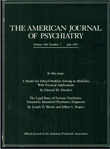Characterizing Psychiatry With Findings From the 1996 National Survey of Psychiatric Practice
Abstract
OBJECTIVE: The authors' goal was to characterize psychiatric practice by reporting findings from the 1996 National Survey of Psychiatric Practice. METHOD: A random sample of 1,481 APA members was selected to participate in the study; 1,375 APA members were determined to be eligible for study participation. The authors report data from 970 respondents (70.5% response rate) and compare them with data from previous surveys of psychiatrists. RESULTS: Twenty-five percent of the participating psychiatrists were women, compared with 19% in a 1988–1989 survey. Since 1988–1989, the proportion of psychiatrists 39 years old or younger has decreased and the proportion of those 55 years old or older has increased. In 1996, psychiatrists saw, on average, 35.4 unduplicated patients and worked an average of 46.4 hours in a typical week. Patients with mood disorders as their primary diagnoses accounted for the greatest proportion of psychiatrists' caseloads, followed by patients with anxiety disorders, then those with schizophrenia and other psychotic disorders. Public sources of payment and uncompensated care were the main sources of payment for psychiatrists services for 41.7% of patients. The primary payment mechanism for psychiatrists' patient care services was fee-for-service, accounting for 52.5% of psychiatrists' income from direct patient care. Twenty-nine percent of psychiatric patients received care through some form of managed care system, and 41.6% received treatment through a nonmanaged public or private health plan. CONCLUSIONS: As psychiatry moves into the next century, findings from the National Survey of Psychiatric Practice will form a baseline for monitoring changes and trends in the delivery and financing of mental health services.



